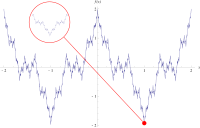Weierstrass function

The Weierstrass function is a mathematical way of drawing a really bumpy, wavy line.
Imagine you have a really long piece of paper and a pencil. You start by drawing a straight line across the paper.
Then you take a loop of string and wrap it around the pencil. This loop of string has bumps in it, like a roller coaster.
You trace the string onto the paper, following the bumps up and down. When you get to the end of the string, you move the pencil a little bit to the side and trace the string again, and again, and again, until you get to the end of the paper.
The resulting line looks really bumpy and wavy, like the hills and valleys of a roller coaster.
The Weierstrass function is like this process but using an equation instead of a loop of string. Mathematicians use this equation to make a line that is infinitely bumpy and wavy.
It's a little bit complicated, but basically, the equation has two parts: a constant value, and a series of terms that have a sinusoidal (wave-like) pattern. All the terms are added together, and as you add more and more of them, the line gets bumpier and wavier.
What's really cool about the Weierstrass function is that it's continuous everywhere, which means there are no gaps or jumps in the line. But it's not a function you can easily draw on paper because it has an infinite number of bumps and wiggles!
Imagine you have a really long piece of paper and a pencil. You start by drawing a straight line across the paper.
Then you take a loop of string and wrap it around the pencil. This loop of string has bumps in it, like a roller coaster.
You trace the string onto the paper, following the bumps up and down. When you get to the end of the string, you move the pencil a little bit to the side and trace the string again, and again, and again, until you get to the end of the paper.
The resulting line looks really bumpy and wavy, like the hills and valleys of a roller coaster.
The Weierstrass function is like this process but using an equation instead of a loop of string. Mathematicians use this equation to make a line that is infinitely bumpy and wavy.
It's a little bit complicated, but basically, the equation has two parts: a constant value, and a series of terms that have a sinusoidal (wave-like) pattern. All the terms are added together, and as you add more and more of them, the line gets bumpier and wavier.
What's really cool about the Weierstrass function is that it's continuous everywhere, which means there are no gaps or jumps in the line. But it's not a function you can easily draw on paper because it has an infinite number of bumps and wiggles!
Related topics others have asked about:
